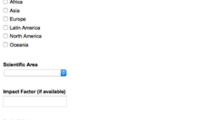Abstract
The concept of citer analysis investigated earlier by Ajiferuke and Wolfram (In: B. Larsen, J. Leta (eds.) Proceedings of the 12th international conference of the international society for scientometrics and informetrics (ISSI) pp. 798–808, 2009, Scientometrics 83:623–638, 2010) is extended to journals where different citing units (citers, citing articles, citing journals) are compared with the journal impact factor and each other to determine if differences in ranking arise from different measures. The citer measures for the 31 high impact journals studied from information science and library science are significantly correlated, even more so than the earlier citer analysis findings, indicating that there is a close relationship among the different units of measure. Still, notable differences in rankings for the journals examined were evident for the different measures used, especially from either 5-year impact factor or number of citing articles per publication to the number of citing journals per publication. The journals that are adversely affected seem to be those whose citations are concentrated in a few journals. This informed the need to develop a journal citation concentration index, which can serve as a complementary measure to the existing journal impact indices.



Similar content being viewed by others
References
Ajiferuke, I., Lu, K., & Wolfram, D. (2010). A comparison of citer and citation-based measure outcomes for multiple disciplines. Journal of the American Society for Information Science and Technology, 61(10), 2086–2096.
Ajiferuke, I., Lu, K., & Wolfram, D. (2011). Who are the disciples of an author? Examining recitation and oeuvre citation exahaustivity. Journal of Informetrics, 5(2), 292–302.
Ajiferuke, I., & Wolfram, D. (2009). Citer analysis as a measure of research impact: Library and information science as a case study. In B. Larsen & J. Leta (Eds.), Proceedings of the 12th international conference of the international society for scientometrics and informetrics (ISSI) (pp. 798–808). Rio de Janeiro.
Ajiferuke, I., & Wolfram, D. (2010). Citer analysis as a measure of research impact: library and information science as a case study. Scientometrics, 83(3), 623–638.
Althouse, B. M., West, J. D., Bergstrom, C. T., & Bergstrom, T. (2008). Differences in impact factor across fields and over time. Journal of the American Society for Information Science and Technology, 60(1), 27–34.
Archambault, E., & Larivière, V. (2009). History of the journal impact factor: contingencies and consequences. Scientometrics, 79, 635–649.
Bergstrom, C. T., West, J. D., & Wiseman, M. A. (2008). The Eigenfactor metrics. The Journal of Neuroscience, 28(45), 11433–11434.
Bollen, J., Van de Sompel, H., Smith, J. A., & Luce, R. (2005). Toward alternative metrics of journal impact: a comparison of download and citation data. Information Processing and Management, 41(6), 1419–1440.
Dieks, D., & Chang, H. (1976). Differences in impact of scientific publications: some indices derived from a citation analysis. Social Studies of Science, 6, 247–267.
Egghe, L. (2012). A rationale for the relation between the citer h-index and the classical h-index of a researcher. Scientometrics, 1-4.
Franceschini, F., Maisano, D., Perotti, A., & Proto, A. (2010). Analysis of the ch-index: an indicator to evaluate the diffusion of scientific research output by citers. Scientometrics, 85(1), 203–217.
Garfield, E., & Sher, I. H. (1963). New factors in the evaluation of scientific literature through citation indexing. American Documentation, 14(3), 195–201.
Glänzel, W., & Moed, H. F. (2002). Journal impact measures in bibliometric research. Scientometrics, 53(2), 171–193.
Gonzalez-Pereira, B., Guerrero-Bote, V. P., & Moya-Anegón, F. (2010). A new approach to the metric of journals’ scientific prestige: the SJR indicator. Journal of Informetrics, 4(3), 379–391.
Hirsch, J. E. (2005). An index to quantify an individual’s scientific research output. Proceedings of the National Academy of Sciences, 102, 16569–16572.
Ioannidis, J.P. (2006). Concentration of the most-cited papers in the scientific literature: Analysis of journal ecosystems. PLoS One, 1(1), e5. http://www.plosone.org/article/info%3Adoi%2F10.1371%2Fjournal.pone.0000005.
MacRoberts, M. H., & MacRoberts, B. R. (1989). Problems of citation analysis: a critical review. Journal of the American Society for Information Science, 40(5), 342–349.
Moed, H. F., Colledge, L., Reedijk, J., Moya-Anegon, F., Guerrero-Bote, V., Plume, A., et al. (2012). Citation-based metrics are appropriate tools in journal assessment provided that they are accurate and used in an informed way. Scientometrics, 92(2), 367–376.
Pendlebury, D. A. (2009). The use and misuse of journal metrics and other citation indicators. Archivum Immunologiae et Therapiae Experimentalis, 57(1), 1–11.
Pratt, A. D. (1977). A measure of class concentration in bibliometrics. Journal of the American Society for Information Science, 28(5), 285–292.
Rousseau, R. (2002). Journal evaluation: technical and practical issues. Library Trends, 50(3), 418–439.
Rousseau, R. (2012). Updating the journal impact factor or total overhaul? Scientometrics, 92, 413–417.
Smalheiser, N. R., & Torvik, V. I. (2009). Author name disambiguation. Annual Review of Information Science and Technology, 43(1), 1–43.
Strotmann, A., Zhao, D., & Bubela, T. (2009). Author name disambiguation for collaboration network analysis and visualization. Proceedings of the American Society for Information Science and Technology, 46(1), 1–20.
Vanclay, J. K. (2012). Impact factor: outdated artefact or stepping-stone to journal certification? Scientometrics, 92, 211–238.
Zitt, M., & Bassecoulard, E. (1998). Internationalization of scientific journals: a measurement based on publication and citation scope. Scientometrics, 41(1), 255–271.
Acknowledgments
This study represents an expanded version of a paper presented at the 14th International Society for Scientometrics and Informetrics Conference held in Vienna in July 2013.
Author information
Authors and Affiliations
Corresponding author
Additional information
Kun Lu: This research was conducted while the author was a member of the faculty at the School of Information Management, Wuhan University, Wuhan, Hubei, China.
Rights and permissions
About this article
Cite this article
Lu, K., Ajiferuke, I. & Wolfram, D. Extending citer analysis to journal impact evaluation. Scientometrics 100, 245–260 (2014). https://doi.org/10.1007/s11192-014-1274-y
Received:
Published:
Issue Date:
DOI: https://doi.org/10.1007/s11192-014-1274-y



